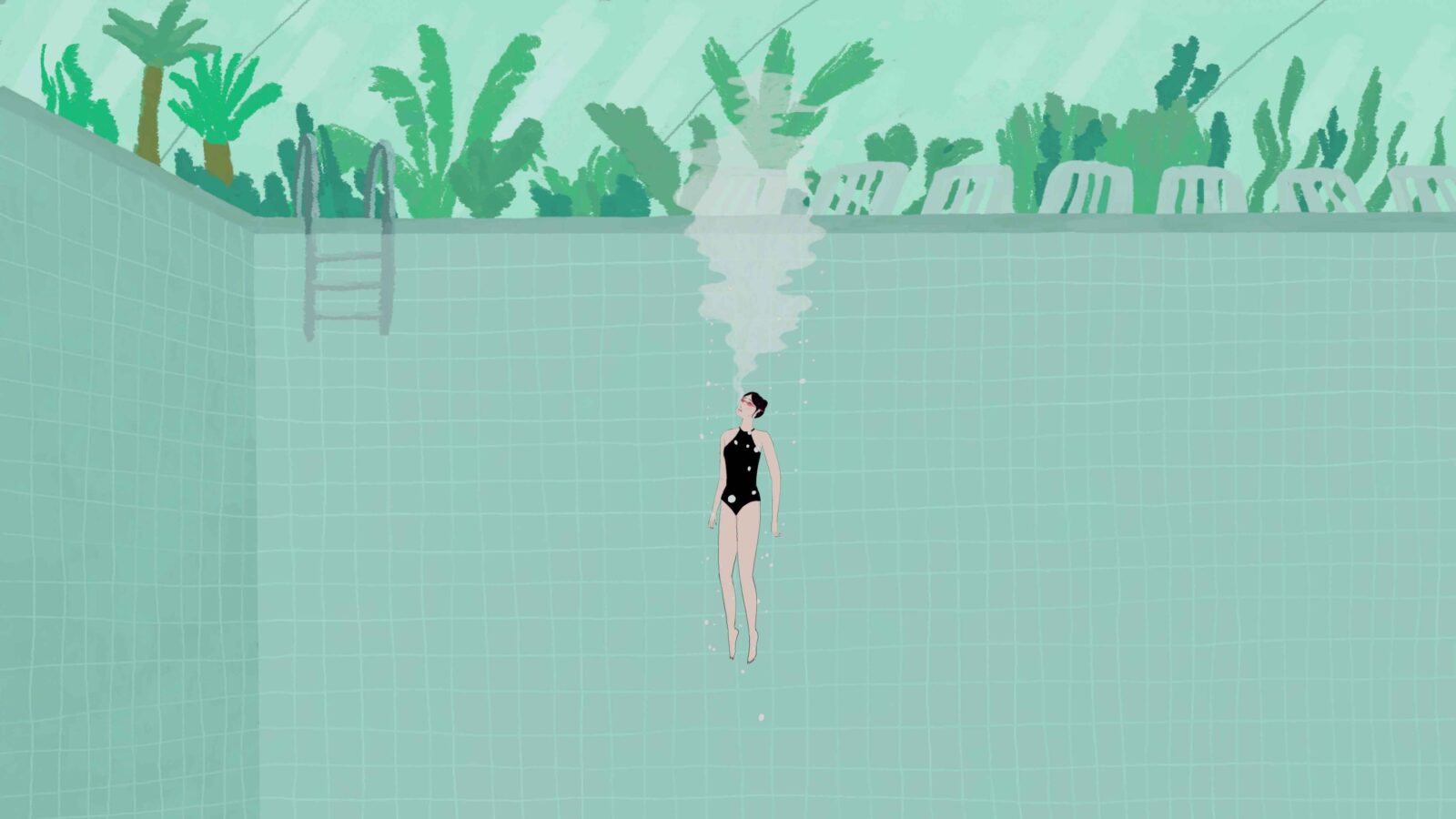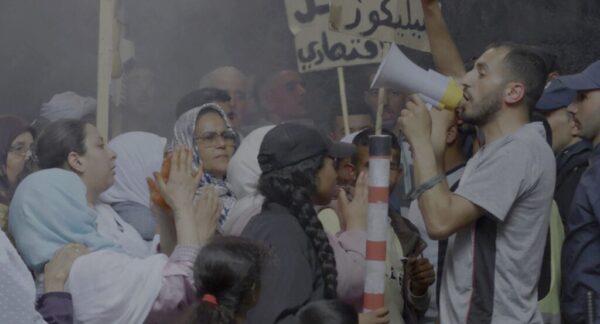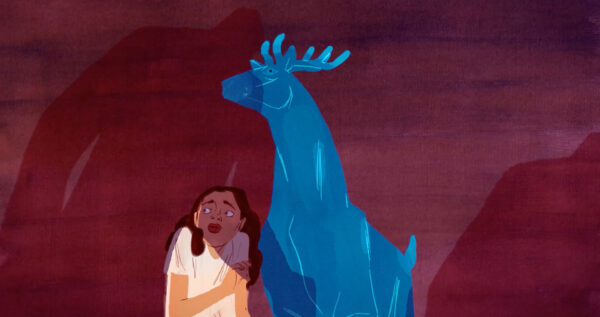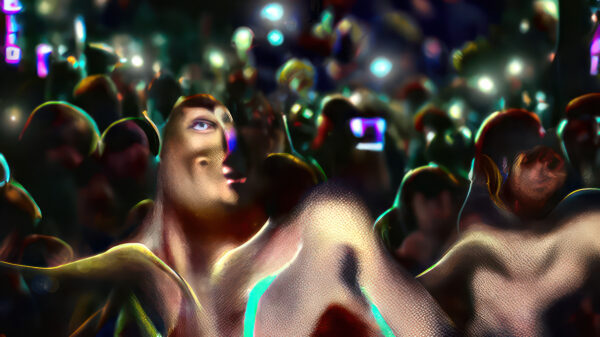Patterns Of Modern Jealousy
Symbiosis
In Symbiosis, Hungarian animator Nadja Andrasev tells the story of a deceived wife who starts a bizarre investigation of her husband’s infidelities.

Hungarian animator Nadja Andrasev’s animation film Symbiosis tells the story of a deceived wife who begins a bizarre investigation of her husband’s infidelities. What starts as jealousy grows into scrupulous research, bordering with voyeurism. The wife follows the cheater, tracks down his numerous lovers, and starts to collect a freakish scrapbook of evidence. Andrasev compares jealousy and the jungle, depicting the betrayed wife in her husband’s tropical hunting field. We know that female hunters rule this animal planet while the guy passively enjoys and obeys.
Symbiosis is an aesthetically pleasing film: bright precious stone colours—emerald, ruby, sugilite purple—dominate and strongly contrast the film’s otherwise ascetic surroundings. Despite being highly decorative, images are decluttered from unnecessary embellishments, leaving place solely for the items that serve a purpose. Andrasev has shaped an urban environment with high skyscrapers, whose windows serve as walls, captivating each character in a glass shell. Regrettably, this couple’s modern minimalistic apartment accompanies their modern minimalistic marriage. Is this what some relationships have become—treating spouses as distant roommates? The absence of dialogue adds to the lack of communication between the couple. The only rare emitted sounds in Symbiosis are distant chattering and a routine “hey”.
By diluting animation with real-life images from women’s booty call photos, Symbiosis breaks the wall between an animated illusion and realistic adultery. The lack of character identification reinforces this feeling. Unnamed heroes remind us that an abstract case can quickly become a New York Times “Modern Love” or a cautionary tale exchanged between friends during a gossip night.
In Symbiosis, mistresses are associated with insects, birds, and cats of prey (primarily tigers). The scratch marks on her husband’s body show how wild these creatures can be. Nevertheless, a great deal of attention is given to “humanising” them—the audience catches a glimpse of their lives and somewhat sad eyes. Andrasev hasn’t portrayed “the other women” in a bad light, nor the protagonist in a desperate and hysterical one. She is strategically acknowledging the situation. Besides, the more she investigates, the more she tries to redirect her husband’s interest toward her. Regardless of that, her sensual nightgowns don’t arouse him: this man is hungry for new experiences and preoccupied with new bodies to discover. If he shifts his desire that easily, what made him settle down in the first place? The film doesn’t address their past but focuses on present action and reaction.
The wife often observes these extramarital liaisons as a lion who stares at a gazelle, waiting for the best moment to attack. But she never seizes the opportunity, choosing not to confront her spouse. She remains with a straight poker face, possibly masterfully repressing pain and insecurity. On the surface, she is not as hurt or shocked as she is curious. Armed with the discreetness of a private detective and the analytical skills of an anthropologist, she meticulously studies the coded sentiments of text messages, thus carefully constructing personality types. A scrapbook of evidence, consisting of physical artifacts like hair, bikini wax stripes, and underwear, allows drawing analogies with the animal world. Do they have softer “fur”? Bigger hips? Fertile genes? Do their pheromones trigger a stronger chemical reaction?
With the given subject matter, it’s hard to avoid clichés. Andrasev chooses to play with them. The man’s portrayal is very vanilla—ordinary, without any character edges. However, the mockery of this cliché is an authentic approach, showing that the women are the ones orchestrating this parade, while the guy is still living in an illusion that he’s the eligible macho type. He’s too lazy to take all the necessary precautions when hiding his affairs. A lack of guilt makes this particular infidelity even dirtier.
In one scene, the wife traces the husband to a more perverted Eyes Wide Shut-type of gentlemen’s club. In another, she observes him getting lucky in the zoo’s tropical house. He appears to be into kinky stuff, yet he is numb when it comes to his own wife’s sexuality. The unevenly shared blanket in their marital bed illustrates the distance between them.
The protagonist’s journey takes different turns and twists. Jealousy triggers research, research triggers comparison, and comparison results in attempts to save the marriage and recreate the sparkle. Unsuccessfully. Symbiosis-wise, the relationship between the couple turns out to be misbalanced and disadvantageous. At the same time, the strange connection between all the involved women can be seen as more symbiotic and mutual. This statement traces the film back to the opening sequence, where the protagonist lets a mosquito suck her blood rather than kill the parasite. After seeing that the mistresses themselves are lonely and dissatisfied, proving that her husband fails to fulfill their desires, the nameless wife makes her piece with these “species” the same way she does with the mosquito—a strange coexistence.




There are no comments yet, be the first!